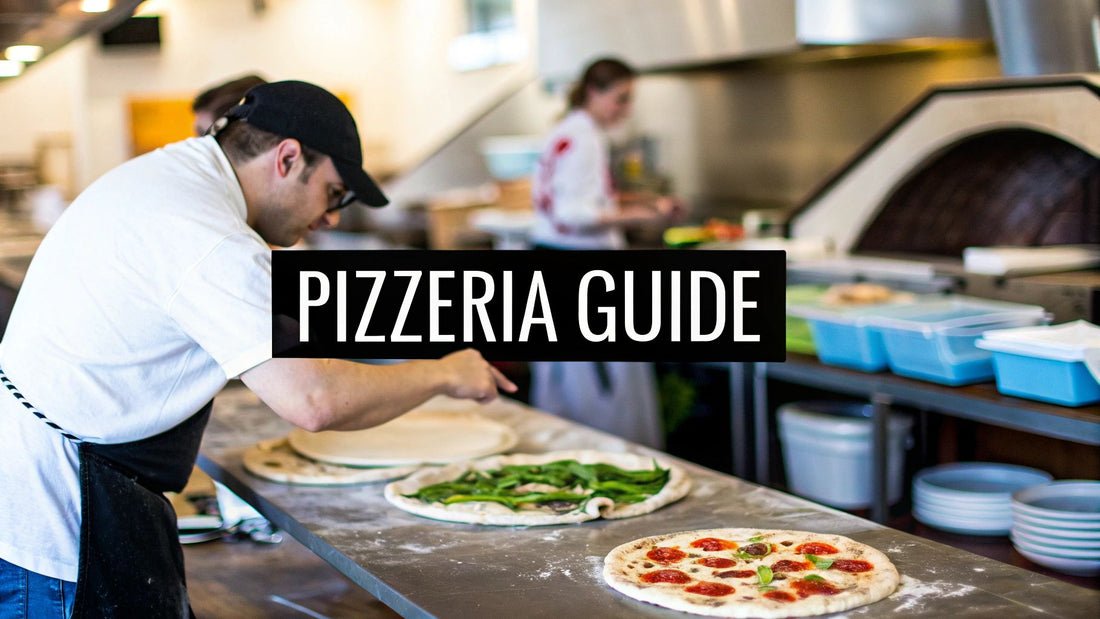
How to Start a Pizza Restaurant Business: A Complete Guide
Share
Opening a pizza restaurant is a huge undertaking, a step-by-step journey from scribbling an idea on a napkin to finally unlocking the doors. It's about nailing down a unique concept, crafting a solid business plan, securing the funds, and navigating the maze of licenses. For a pizzeria, that journey hinges on a strong identity—are you an authentic Neapolitan spot or a classic New York slice shop? That one decision influences everything, especially specialized gear like a reliable pizza prep table. Careful planning is what turns that fire in your belly into a business that actually lasts.
Defining Your Unique Pizzeria Concept
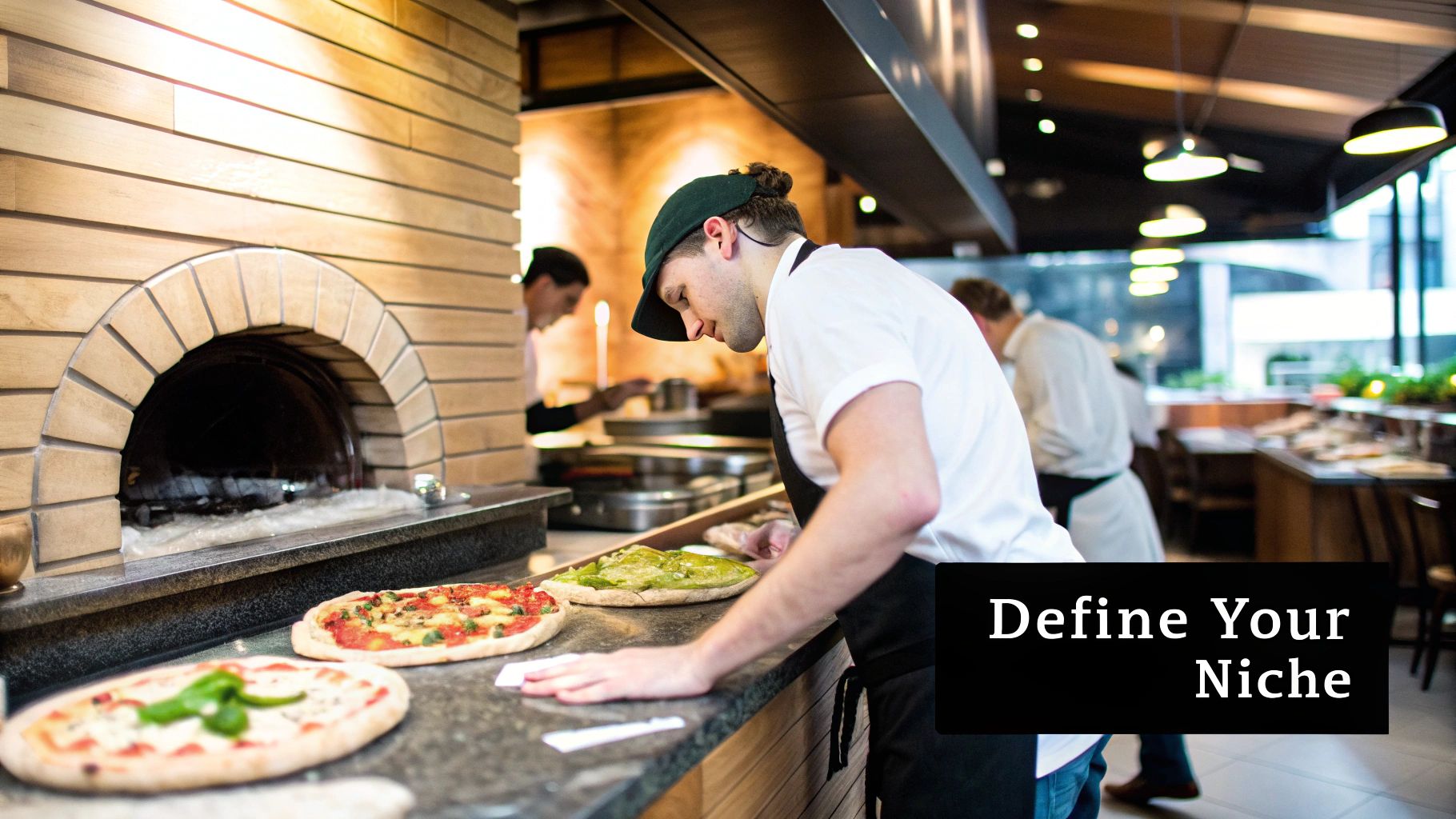
Before you even think about buying a single bag of flour or looking at equipment, you need to lock down your core concept. What kind of pizzeria are you going to be? This isn't just about the food. This question is the foundation for your brand, your customers, and every single choice you'll make from here on out.
Just deciding to open a "pizza place" is a recipe for getting lost in the crowd. The U.S. pizzeria industry is a $47 billion behemoth, so you need a specific, compelling identity that makes people remember you.
Choosing Your Pizza Niche
Your niche is your fingerprint on the local food scene. Think about the pizzerias you love—they almost always have a specialty. This kind of focus makes your life easier operationally, but it also makes your marketing a hell of a lot more effective.
Here are a few proven concepts to get you thinking:
- Authentic Neapolitan: This is for the purists. It's all about tradition, from the specific flour and tomatoes to the blistering-hot, wood-fired oven. You're not just selling pizza; you're selling an authentic experience.
- New York Style: Big, foldable slices with that classic thin, crisp-yet-chewy crust. This is an American icon, perfect for a fast-casual, by-the-slice joint in a spot with tons of foot traffic.
- Chicago Deep-Dish: This is an event, not a quick slice. It's a hearty, indulgent pie that works perfectly for a family-style, sit-down restaurant trying to become a destination.
- Gourmet or Artisanal: Here, you're playing with high-quality, unique ingredients—think truffle oil, prosciutto, or inventive vegan cheeses. You're targeting foodies who will gladly pay a premium for creativity.
Your choice here has a direct ripple effect on your kitchen layout. A high-volume New York-style shop needs a different pizza prep table than a small artisanal spot. The former needs a mega-top unit to hold tons of toppings, while the latter might care more about counter space and less about cold storage.
Understanding Your Local Market
Got a concept in mind? Great. Now it's time to play detective. Market research isn't about staring at spreadsheets; it's about figuring out what your community is secretly craving.
Start by scoping out the local competition. Don't just see who sells pizza, but how they sell it. Is your town drowning in cheap, fast-food chains? That could be a golden opportunity for a quality-driven, family restaurant. Are there plenty of sit-down places but nowhere to grab a quick slice near all the downtown offices? You just found a gap in the market.
A successful concept is born at the intersection of your passion and a genuine market need. Don't build what you think is cool; build what your future customers are actively looking for but can't find.
From Food to Full Experience
A killer concept goes way beyond the menu. It shapes the entire vibe and is the secret to building a base of loyal, repeat customers.
Think about these key elements:
- Service Style: Will you be a fast-casual spot where people order at the counter? A full-service restaurant with servers? Or a lean, mean, delivery-and-takeout machine?
- Atmosphere: Is your brand modern and sleek, rustic and cozy, or loud and family-friendly? The music, the lighting, the art on the walls—it all needs to tell the same story.
- Brand Voice: How do you talk to people? Your brand's personality has to be consistent everywhere, from your website and social media captions to how your staff answers the phone.
For instance, a pizzeria slinging authentic Neapolitan pies should feel warm and rustic, a little slice of old-world Italy. On the flip side, a shop selling creative vegan pizzas would probably kill it with a modern, bright, and eco-conscious brand. When you nail this cohesive concept from day one, you build a rock-solid foundation for everything that comes next.
Building Your Business Plan And Securing Funding
Okay, you've nailed down your pizzeria concept. Now comes the part that separates the dreamers from the doers: translating that vision into a rock-solid business plan.
Don’t roll your eyes. This document is way more than just a formality for the bank. It’s your operational roadmap—the single most important tool you'll have for convincing lenders and investors that your pizza place is a sound bet. A killer plan proves you’ve thought through every single detail, from marketing angles to financial projections. Think of it as the blueprint for your entire operation.
Crafting a Compelling Executive Summary
Your executive summary is the first thing a potential investor reads, and honestly, it might be the only thing. It has to be a powerful, concise overview of your entire plan that grabs them by the collar from the first sentence.
This isn't the place for fluff. Get straight to the point and clearly articulate:
- Your Mission: What’s the core purpose of your pizzeria?
- Your Concept: Briefly describe your unique pizza style and who you're selling it to.
- The Opportunity: Why is your pizzeria going to succeed in this market, right now?
- Financial Highlights: Give them the key numbers—your funding request, projected revenue, and when you expect to be profitable.
This is your elevator pitch on paper. Make it sharp, confident, and compelling enough to make them eager to read the rest.
Detailing Your Operations and Market Analysis
This is where you get into the real nuts and bolts of how your pizzeria will run day-to-day. You’re proving you understand both your own business and the competitive jungle you’re about to step into. You'll need to outline your company structure, who's on your management team, and the unique value you're bringing to the table.
A thorough competitive analysis is non-negotiable here. Identify every other pizzeria in your target area and break down their strengths and weaknesses. What are their price points? Who are their customers? This isn't about copying them; it's about finding your unique angle to carve out your own loyal following.
A business plan is your best defense against the harsh realities of the restaurant industry. It’s the structured thinking that separates a passionate idea from a profitable, long-lasting business.
The industry is notoriously tough. Statistics show that while 60% of new restaurants survive their first year, only about 20% make it past the five-year mark. That stat alone should tell you how critical sound financial planning is from day one.
Creating Realistic Financial Projections
Here’s where the rubber meets the road. You’re putting hard numbers to your vision, and you can bet this is the section investors will scrutinize the most. Your projections need to be detailed, well-researched, and above all, believable. Plan on projecting your finances for at least the first three to five years.
Your financial section must include:
- Startup Costs: This is a line-by-line list of every single one-time expense needed to open your doors. It covers everything from big-ticket kitchen equipment like your pizza prep table and oven to initial inventory, permits, and legal fees.
- Profit and Loss (P&L) Statement: This projects your revenue, cost of goods sold (COGS), and operating expenses over time to show exactly when you expect to become profitable.
- Cash Flow Analysis: This tracks the actual cash moving in and out of your business. It's crucial for ensuring you have enough liquid capital to cover payroll and pay suppliers each month, especially in the early days.
Don't just pull these numbers out of thin air. Research local ingredient costs, average labor rates in your area, and utility expenses. For a detailed guide on what to budget for, check out our complete restaurant startup costs breakdown for a checklist of expenses you can’t afford to overlook.
Securing the Capital You Need
With a polished business plan in hand, you're finally ready to go ask for the money. There are several paths you can take, and each one has its own set of pros and cons for a new pizza restaurant.
Most new owners explore one of these common funding sources:
- Traditional Bank Loans: Banks can offer great interest rates, but they're conservative. They’ll want to see a strong credit history, significant collateral, and a flawless business plan before they even consider it.
- SBA Loans: These loans are backed by the Small Business Administration, which reduces the risk for lenders and makes them more accessible for startups. The application process can be a beast, but the favorable terms make them a top choice for a reason.
- Private Investors or Partners: Bringing on an investor means giving up a slice of your company. But the right partner can bring more than just cash—they can offer invaluable industry experience and mentorship that you can't put a price on.
When you present your plan, be ready to defend every single assumption and projection. Lenders want to see that you have a deep, realistic understanding of the financial road ahead and a clear, actionable strategy to build a pizzeria that doesn't just survive, but thrives.
Navigating Restaurant Licenses And Permits
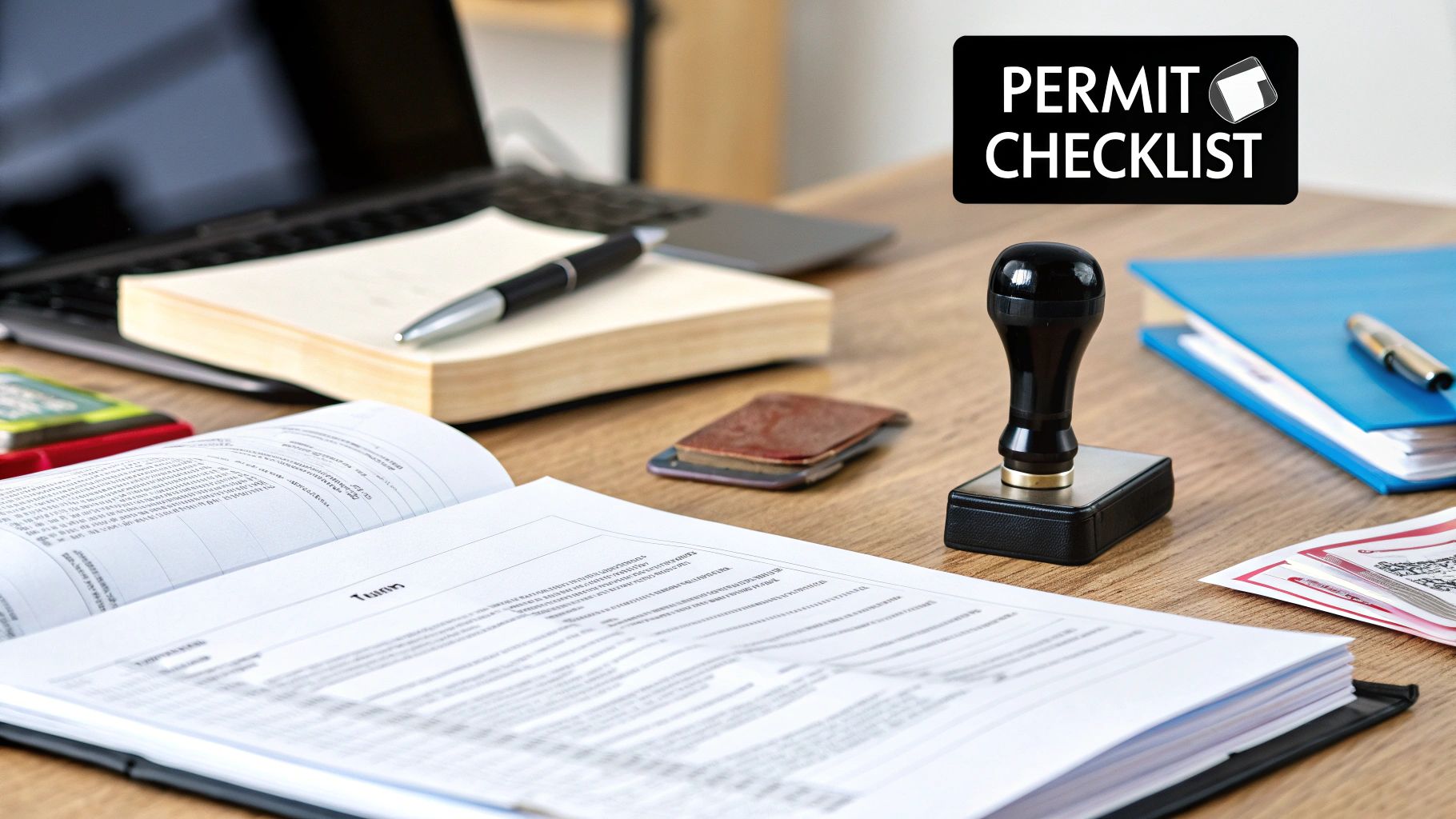
Alright, you've got a killer concept and a solid business plan. Now comes the part that makes a lot of new owners sweat: the unavoidable mountain of paperwork.
Let's be honest, navigating the world of licenses and permits can feel like a maze designed by bureaucrats. But getting this right from the start is non-negotiable. It's the legal foundation of your business, and skipping a step here can lead to costly fines or, even worse, a delayed grand opening.
The specific permits you'll need can change dramatically from one town to the next. Always, and I mean always, start by checking with your local city, county, and state government websites. Think of it as the very first inspection your business has to pass.
Core Licenses Every Pizzeria Needs
Before you can even dream of firing up that new oven, there are a few essential permits that virtually every food business in the country needs. These are the big ones the authorities will ask for first.
My advice? Get a binder or create a digital folder today. For every application you submit, track the date, the fee you paid, and the name of the person you spoke with. This simple habit will save you from countless headaches later.
Here are the usual suspects:
- Business License: This is your basic ticket to the game. It grants you the legal right to operate any kind of business in your city or county.
- Food Service License: Issued by your local health department, this license is proof that your pizzeria meets all the critical food safety regulations.
- Certificate of Occupancy: This one confirms your building is safe for the public and complies with all local building and zoning codes. You can't open your doors without it.
Getting your licenses in order isn't just about avoiding fines. It's about establishing credibility and proving to your community—and your future staff—that you're running a professional, safe, and legitimate operation.
Health and Safety Compliance
The health department is arguably your most important partner in this process. Their job is to protect public health, and they take it seriously. Acing their initial inspection is the key to getting that all-important food service license.
They will scrutinize everything, from your kitchen layout and food storage procedures to your sanitation systems. They'll pay close attention to critical equipment, like your pizza prep table, to ensure it holds perishable toppings at the correct, safe temperature.
Want to get ahead of the game? We put together a detailed restaurant health inspection checklist that breaks down exactly what inspectors are looking for. Review it before they show up.
Specialized and Location-Specific Permits
Beyond the basics, you’ll likely run into a few other permits depending on your specific plans. For instance, planning a renovation? You’ll need building permits before a single wall comes down. Want to hang that cool "Grand Opening" sign out front? Yep, you'll probably need a sign permit for that.
And then there's the big one: the liquor license. If you plan to serve beer and wine with your pizza—a huge revenue driver for most pizzerias—get ready for a separate, often lengthy process. Liquor license applications can take months and usually involve detailed background checks. Start that paperwork as early as humanly possible.
Designing Your Kitchen And Choosing Equipment
The dining room might create the ambiance, but let's be real—the kitchen is the engine of your entire pizzeria. A smart, efficient kitchen layout is the secret sauce to a smooth and profitable operation. This is where your concept gets real, and where your crew needs to be able to crank out consistently amazing pizzas, even when the Friday night rush hits like a tidal wave.
Think of your kitchen's design as a production line. Ingredients come in, dough gets prepped, pizzas are assembled, they hit the oven, and then they're boxed or plated. Every single station—from washing and prep to the cook line and service—needs to be arranged logically to cut down on wasted steps and keep your staff from doing the "kitchen dance" around each other. Trust me, a cramped or poorly planned kitchen is a one-way ticket to slow ticket times, inconsistent food, and a burned-out team.
The infographic below breaks down the core process, from sketching out your layout to balancing the budget for your most important gear.
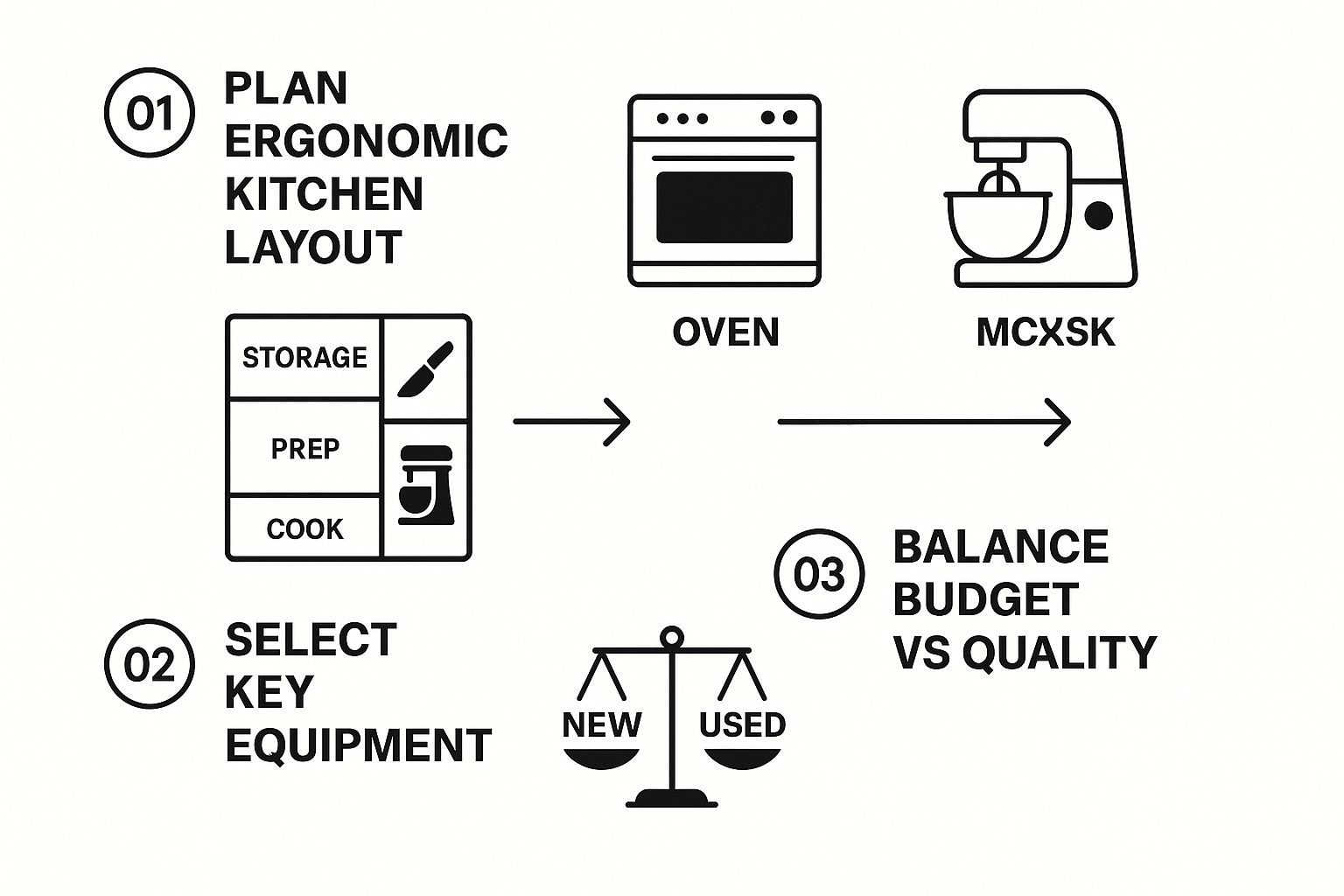
As you can see, the layout comes first. It directly dictates the equipment you'll need and how you'll split your budget between brand-new and pre-owned pieces.
The Heartbeat of Production: The Pizza Prep Table
For any pizzeria, the pizza prep table is the undisputed command center. It's where your ingredients, dough, and staff all come together to build your signature product. Picking the right one is one of the most critical equipment decisions you'll make, and it will have a direct impact on your speed and efficiency every single day.
There’s no one-size-fits-all answer here. The best table for your shop depends entirely on your pizzeria's volume and how complex your menu is.
To help you decide, let's look at the main players. Each one is designed for a specific type of kitchen workflow and output.
Pizza Prep Table Comparison
| Feature | Standard Pizza Prep Table | Mega-Top Pizza Prep Table | Drawered Pizza Prep Table |
|---|---|---|---|
| Best For | Small to mid-sized pizzerias with a focused menu. | Operations with a wide variety of toppings and high volume. | Kitchens prioritizing speed, organization, and portion control. |
| Topping Capacity | Standard single row of pans. Good for core ingredients. | An extra row of pans, offering up to 50% more capacity. | Varies, but the focus is on quick access from drawers below. |
| Workflow Benefit | Simple, efficient for classic pizza-making. | Reduces trips to the walk-in for restocking during a rush. | Shaves seconds off every order with pre-portioned items. |
| Organization | Basic; relies on pan arrangement in the rail. | Excellent for keeping a large number of toppings organized. | Superior organization for dough balls, cheese, and ingredients. |
Choosing the right table comes down to being honest about your menu and projected sales. A standard table is a great starting point, but if you're planning a dozen specialty pizzas, a Mega-Top will prevent major bottlenecks on a busy night.
Your pizza prep table isn't just a piece of equipment; it's the central hub of your entire production process. Investing in the right size and type for your specific volume and menu is a direct investment in your kitchen's speed and consistency.
Selecting Your Core Cooking and Prep Equipment
Beyond the prep table, a few other pieces of gear are absolutely non-negotiable for a professional pizzeria. Your choices here will define not only your pizza's final character but your kitchen's overall capacity.
Your commercial pizza oven is hands-down the biggest investment. The type you choose literally dictates the style of pizza you'll make. A deck oven is the classic choice for New York style, giving you that perfect crisp crust. A conveyor oven is a must for high-volume, fast-casual spots that need killer consistency. And if you're going for authentic Neapolitan, a brick or wood-fired oven is the only way to go.
Next up is your commercial dough mixer. Let’s be clear: mixing dough by hand just isn't scalable. A good spiral or planetary mixer ensures you have a consistent, high-quality dough base every single day, which is the foundation of any great pizza. To make sure you've covered all your bases, take a look at this detailed commercial kitchen equipment checklist so you don't miss any essentials.
Balancing Budget, Quality, and Space
Outfitting a commercial kitchen is a serious expense, with total equipment costs often running anywhere from $100,000 to $300,000. This is where you have to make some tough, smart decisions about buying new versus used.
Here’s a practical way to think about it:
- Buy New When Reliability is Critical: Your core refrigeration, especially that pizza prep table, should be purchased new. A failed compressor on a used unit during a dinner rush could cost you thousands in lost sales and spoiled food. New equipment comes with warranties and the peace of mind that it will work when you need it most.
- Consider Used for Sturdy, Simple Items: Things with fewer moving parts—like stainless steel work tables, shelving, and sinks—are perfect candidates for the used market. You can often find high-quality, pre-owned pieces for a fraction of what they'd cost new.
- Leasing as an Alternative: If your upfront capital is tight, leasing major equipment like your oven or mixer can be a brilliant move. This turns a massive capital expense into a predictable monthly operational cost, freeing up cash for all the other things you'll need when starting up.
Ultimately, your goal is to build a high-functioning kitchen that empowers your team to work efficiently and produce an outstanding product, every single time.
Building Your Team and Engineering Your Menu
Once your kitchen layout is locked in and the legal paperwork is filed away, you get to the fun part—the soul of your pizzeria. This is all about your people and your menu. Your crew is the face of your brand, and your food is the entire reason people walk through your doors. Nail these two, and you’re building a business that can go the distance.
Hiring is where it all begins. Look past the resume for a minute and search for genuine passion. I’ve seen it a hundred times: a pizza chef who truly loves the craft or a server who gets a real kick out of making someone's day will always create a better vibe than someone just punching a clock. That energy is contagious, and your customers will feel it.
Assembling Your Pizzeria Crew
Hiring the right people is easily one of the most critical parts of opening a pizza restaurant. Your job descriptions need to do more than just list duties; they need to whisper about the culture you’re trying to build.
- For Pizza Chefs: Don't just ask for "cooking skills." Get specific. Mention things like "experience hand-stretching dough" or "proficiency with a deck oven." This weeds out the unqualified folks and attracts the specialists who are proud of their skills.
- For Servers: Personality is everything here. Use phrases like "an engaging and friendly demeanor" or the "ability to connect with guests in a fast-paced environment." You’re not just hiring servers; you're hiring ambassadors.
- For Dishwashers: This is the engine room of your kitchen, plain and simple. Highlight words like reliability and teamwork. This role is absolutely essential for a smooth service, especially when the dinner rush hits hard.
Once you’ve got your team, remember that training is everything. Never assume they know your way of doing things. You need to create standardized training playbooks for both your front-of-house (FOH) and back-of-house (BOH) staff. This ensures every single pizza that leaves the kitchen and every customer interaction is consistent and lives up to the standards you’ve set.
Engineering a Profitable Pizza Menu
Your menu isn't just a list of food. It's your number one sales tool, and you need to treat it that way. This is where menu engineering comes in—it’s the art of designing a menu that subtly guides customers toward your most profitable dishes without making them feel pushed.
First things first, you have to know the profitability of every single item. That means calculating the precise food cost percentage for each pizza, right down to the last olive. The goal is to find that perfect balance between your popular, high-margin items (your "Stars") and those unique, brand-building signature pies.
Your menu should be a curated experience, not a phone book of every topping combination imaginable. A smaller, focused menu that you can execute perfectly is almost always more profitable—and less stressful for a new kitchen—than a massive one.
Balancing the menu is key. Sure, a classic pepperoni pizza might be your volume seller, but a special "Fig & Prosciutto" pie is what gets people talking and brings in the foodies. This kind of variety keeps things interesting and casts a wider net for different types of customers.
Pricing, Sourcing, and Design
Setting your prices is a delicate dance. You have to cover your food costs, labor, and all your overhead, but you also have to stay competitive in your neighborhood. A good rule of thumb is to aim for a food cost of around 28-35% of the menu price, but this can shift depending on your concept and location.
Finding high-quality ingredients from suppliers you can count on is completely non-negotiable. Don't just shop for the lowest price. Building real relationships with local vendors can often get you better deals in the long run and, more importantly, ensures you get the freshest produce. That quality goes directly into your final product.
Finally, think about the physical menu itself. The design should be clean, easy to read, and look appetizing. Use simple tricks like putting a box around your signature pizzas or using bold text to draw attention to high-profit items. A cluttered, confusing menu just makes customers anxious, and they'll often default to ordering the cheapest thing. Your menu's design should be working for you, actively helping you sell.
Marketing Your Pizzeria For A Successful Launch
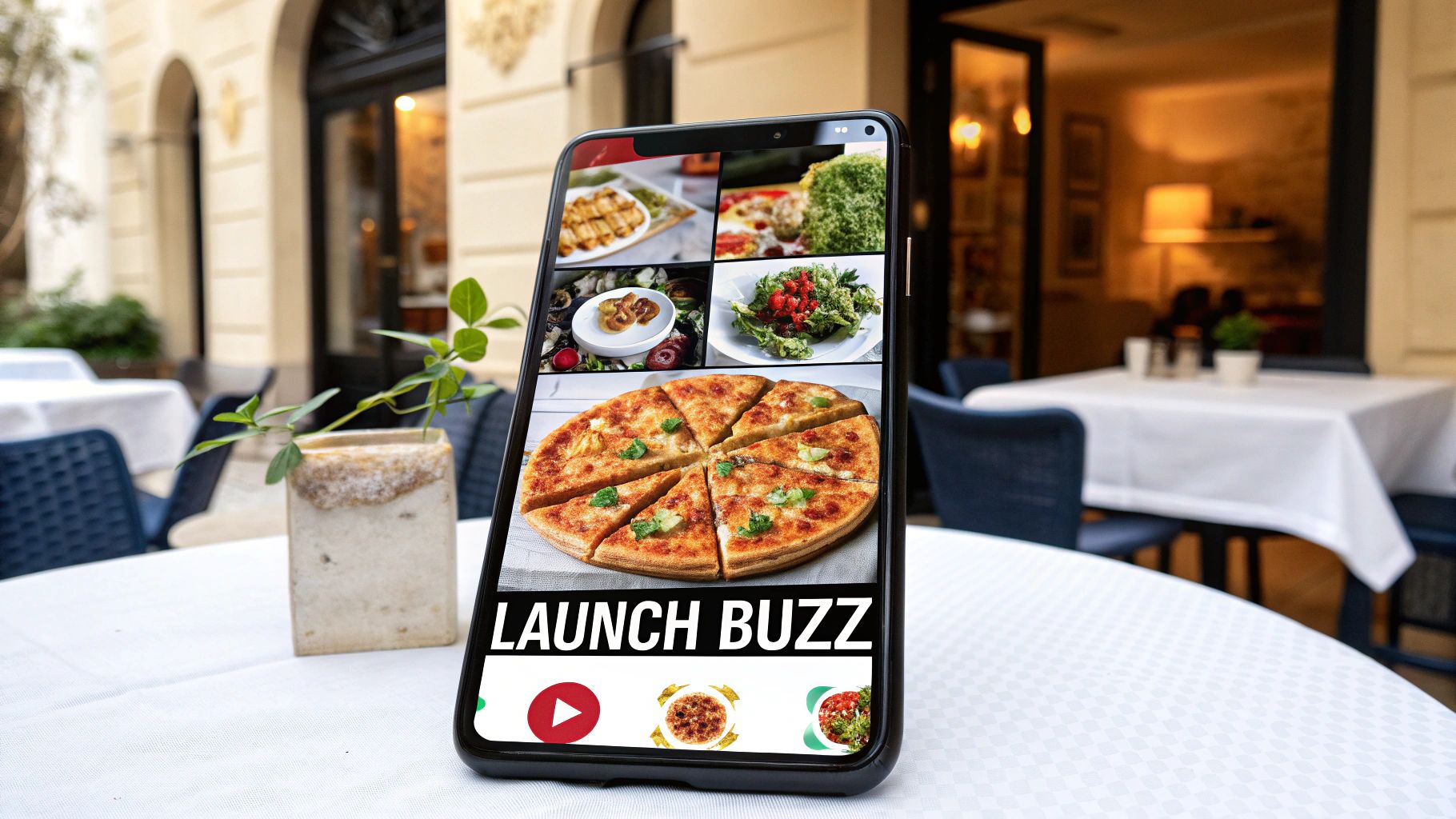
You can have the best pizza in town, but if no one knows you exist, you’re just running an expensive hobby. A smart, proactive marketing plan is what turns a great pizzeria into a real business. It's all about creating a groundswell of excitement before you even fire up the ovens for the first time.
The goal isn't just to have a busy opening day; it's to build momentum that keeps the regulars coming back. This means blending modern digital tactics with classic, old-school local engagement to create a marketing machine that works for you.
Building Your Digital Foundation
These days, your digital storefront is just as important as your physical one. Your first move should be creating a professional, mobile-friendly website. It doesn't need to be complicated, but it absolutely must have your menu, location, hours, and mouth-watering photos of your pizzas.
Your website is the hub, but social media is where you'll build your community. For a pizzeria, Instagram and Facebook are your best friends. These platforms are visual by nature, making them perfect for showcasing gooey cheese pulls and perfectly charred crusts. Start posting content weeks before you open—share behind-the-scenes looks at renovations, introduce your key staff, and run polls asking followers what toppings they're most excited to try.
Your online presence is the modern-day "coming soon" sign. It's your chance to tell your story, build anticipation, and start a conversation with your future regulars long before they can place their first order.
Once your concept is nailed down, you need to implement effective local SEO strategies for restaurants to make sure customers can find you. This involves optimizing your site with local keywords like "best pizza in [Your Town]" and, most importantly, claiming and fully optimizing your Google Business Profile.
Creating Pre-Launch Buzz
A successful launch doesn't happen by accident; it's carefully orchestrated. Pre-launch campaigns are all about building a list of eager customers who can't wait for you to open your doors.
Give these proven tactics a try:
- Early-Bird Offers: Set up a landing page on your new site to collect email addresses. Offer an exclusive discount—like a free appetizer or 25% off their first order—to everyone who signs up before opening day.
- Host a Soft Opening: A few days before the grand opening, invite friends, family, and local business owners for a "practice" run. This is a brilliant way to work out operational kinks in a low-pressure environment while generating priceless word-of-mouth marketing.
- Partner with Local Influencers: Find the local food bloggers or Instagrammers in your area. Invite them in for a complimentary meal during your soft opening in exchange for an honest review or a few social media posts.
These actions do more than just get your name out there. They create a sense of exclusivity and build an initial wave of social proof you can ride right into your grand opening.
Executing a Memorable Grand Opening
All your hard work culminates on opening day. This is your moment to make a powerful first impression. The key is being prepared for the rush you've worked so hard to create. Make sure you have extra staff scheduled for both the kitchen and front-of-house to handle the volume without sacrificing service.
Think of your grand opening as a party. You could hire a local musician, offer a special one-day-only pizza, or run a giveaway for the first 50 customers. Make it an event people want to be part of, not just another meal out.
Most importantly, focus on gathering feedback. You can do this with simple comment cards on each table or by personally checking in with diners. This early feedback is pure gold, helping you quickly identify what's working and what needs a little tweaking to lock in that long-term success.
Common Pizzeria Startup Questions
When you're dreaming of opening your own pizzeria, a few big questions always come to mind. What’s this really going to cost, and what are the traps that sink other new owners?
Let's talk numbers first. A small, focused pizzeria can get off the ground for around $75,000, but a larger spot in a prime location with all-new gear could easily push past $300,000. The biggest variables are always your lease and your equipment—that pizza prep table, for instance, is a critical investment that can swing your budget.
Profitability often comes down to your business model. We've seen that delivery and takeout-heavy pizza concepts tend to have an easier path to profit because they slash the overhead that comes with a large dining room and front-of-house staff.
So, what are the common mistakes? The biggest one is underestimating how much cash you'll need to get through the first six months. Others include picking a location with no foot traffic and, crucially, not marketing the business before the doors even open.
While having restaurant experience is a huge plus, it's not a deal-breaker. I've seen plenty of passionate owners succeed by hiring a fantastic, experienced team. If you want to dive deeper into the nuts and bolts, this comprehensive guide on how to start a restaurant business is a great place to start.
